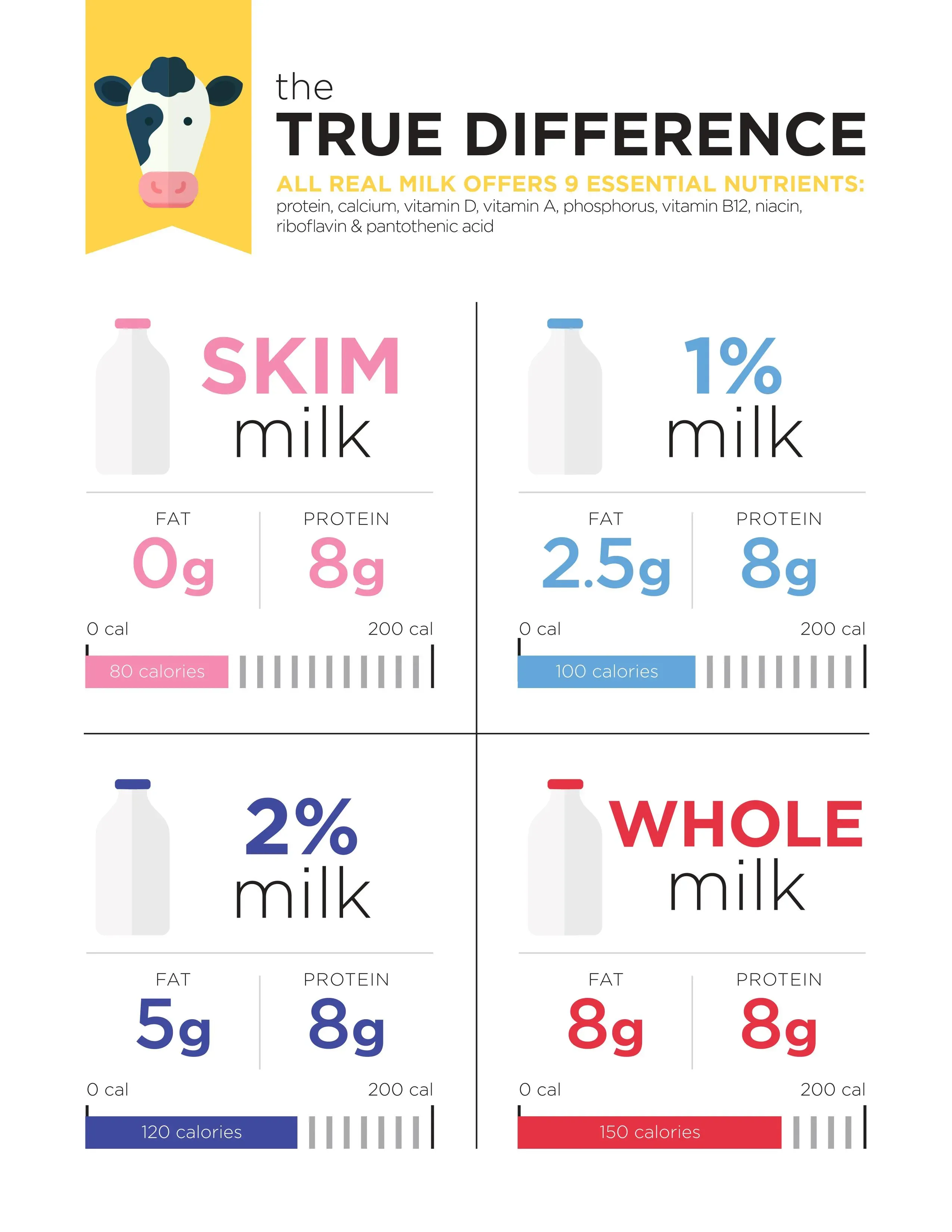Table of Contents
Standing in the dairy aisle can feel like a pop quiz you didn't study for. Whole milk, 2%, 1%, skim – the options stare back at you, each carton whispering conflicting health advice. For decades, the go-to answer was simple: ditch the fat, grab the low fat or skim milk. It was a straightforward equation drilled into us by dietary guidelines focused heavily on limiting saturated fat.
Whole Milk vs. Low Fat Milk: What's the Real Difference?

Whole Milk vs. Low Fat Milk: What's the Real Difference?
Alright, let's cut to the chase. When you grab a carton labeled "whole milk" or "low-fat milk," the most obvious thing staring back at you on the nutrition label is the fat content. That's the headline difference, the one everyone talks about. Whole milk, by definition, contains about 3.25% milk fat by weight. It's the closest you get to milk straight from the cow before they start messing with it. Low-fat milk, often labeled as 1% or 2%, has had some of that fat skimmed off. This isn't some magical process; they literally separate the fat from the liquid and then add back a specific amount to hit that 1% or 2% mark. So, the core distinction in the Whole Milk vs. Low Fat Milk debate boils down to how much of that creamy, fatty goodness is left in the carton.
Here’s a quick look at the typical fat breakdown:
- Whole Milk: Approximately 3.25% milk fat
- Reduced-Fat Milk (2%): Approximately 2% milk fat
- Low-Fat Milk (1%): Approximately 1% milk fat
- Skim or Nonfat Milk: Less than 0.5% milk fat
Beyond the Fat: What Else is in Your Low Fat or Whole Milk?

Beyond the Fat: What Else is in Your Low Fat or Whole Milk?
It's Not Just About the Creaminess
so we've established the fat difference between low fat or whole milk. But let's be real, milk isn't just a vehicle for fat. It's packed with other stuff your body actually needs. Think protein. Milk is a fantastic source of high-quality protein, the building blocks for muscles and pretty much everything else. And here's the kicker: the protein content is remarkably similar whether you're sipping on whole milk or skim. You're getting roughly the same amount of this crucial macronutrient, regardless of the fat level you choose. It's like getting the same sturdy frame for your house, just with slightly different insulation.
Vitamins, Minerals, and the Fortification Factor
Beyond protein, milk brings a decent haul of vitamins and minerals to the table. Calcium, obviously, is the big one everyone thinks of for bone health. Good news: calcium levels don't significantly change between low fat or whole milk. You're getting that bone-building power either way. Vitamin D is another key player, often added to milk because it helps your body absorb calcium. While whole milk naturally contains some fat-soluble vitamins like A, D, E, and K, the fat removal process for lower-fat versions strips some of these out. Manufacturers then typically fortify low-fat and skim milk to bring those vitamin levels back up, particularly vitamins A and D. So, while the *source* of the vitamin might differ (natural vs. added), the *amount* you get can end up being quite comparable.
Nutrient | Whole Milk (approx. per cup) | Low-Fat (1%) Milk (approx. per cup) |
|---|---|---|
Protein | 8 grams | 8 grams |
Calcium | 300 mg | 300 mg |
Vitamin D | Often fortified (~2.4 mcg) | Often fortified (~2.4 mcg) |
Vitamin A | Naturally present + often fortified (~150 mcg) | Fortified (~150 mcg) |
Carbs, Calories, and Everything Else
Then there are the carbohydrates, mostly in the form of lactose, the natural sugar found in milk. This amount is also largely consistent across different fat percentages. The main caloric difference between low fat or whole milk comes down to, you guessed it, the fat. More fat means more calories. A cup of whole milk has around 150 calories, while 1% hovers around 100-110, and skim drops to about 80-90. It’s not a massive swing in the grand scheme of a day's eating, but it's a difference worth noting if you're strictly counting calories. Other trace nutrients and fatty acids are also present, and some of these, particularly certain types of fatty acids, are found in higher amounts in whole milk, which we'll touch on later.
Saturated Fat & Your Heart: The Low Fat or Whole Milk Question

Saturated Fat & Your Heart: The Low Fat or Whole Milk Question
The Old Scare: Saturated Fat is Public Enemy Number One
For decades, the message was clear and loud: saturated fat equals clogged arteries. This fear was the driving force behind the widespread recommendation to choose low fat or skim milk over whole milk. It was based on the understanding that saturated fats raise LDL cholesterol, often called "bad" cholesterol, which was strongly linked to an increased risk of heart disease. The logic was simple: whole milk has more saturated fat than low fat versions, therefore whole milk is worse for your heart. Doctors and dietary guidelines pushed this hard, and most people just accepted it. It felt like a simple equation for better health – just cut the fat.
This perspective led to a massive shift in the dairy aisle. Suddenly, 2%, 1%, and skim milk became the "healthy" options, leaving whole milk looking like a dietary dinosaur. If you grabbed a carton of whole milk, you might have felt a pang of guilt, like you were actively choosing a less healthy path. It was a black and white view of nutrition, where one nutrient was demonized, and removing it seemed like the obvious solution to a complex health problem.
New Research: Is Dairy Fat Different?
Now, hold on a minute. Science has a funny way of evolving, and lately, the script on dairy fat has started to flip. Newer research isn't so convinced that the saturated fat in milk behaves the same way as saturated fat from, say, a cheeseburger. Some studies suggest that the overall "package" of nutrients in milk – what scientists sometimes call the 'dairy matrix' – might influence how the body processes the fat. Things like calcium, protein, and other fatty acids in milk could potentially mitigate the negative effects traditionally associated with saturated fat alone.
We're seeing studies that don't find a strong link between full-fat dairy consumption and increased heart disease risk, and some even suggest potential benefits. It's a head-scratcher for those who grew up in the low-fat era. This doesn't mean you can suddenly chug gallons of whole milk without consequence, but it does mean the simple "saturated fat is bad" rule might be too simplistic when it comes to dairy. The conversation around low fat or whole milk is getting more nuanced, looking beyond just one number on the nutrition label.
So, what are some of these dairy fatty acids getting a closer look?
- Butyric Acid (C4:0): A short-chain fatty acid, linked to gut health.
- Caproic, Caprylic, Capric Acids (C6:0, C8:0, C10:0): Medium-chain fatty acids.
- Palmitic Acid (C16:0): A saturated fat, but its effects might be influenced by the 'dairy matrix'.
- Stearic Acid (C18:0): Another saturated fat, some research suggests it has a neutral effect on LDL cholesterol.
- Conjugated Linoleic Acid (CLA): A type of trans fat naturally found in dairy, studied for potential health effects.
Choosing Your Pour: Finding the Right Milk for You
Considering Calories and Saturated Fat (The Traditional View)
so after wading through the fat percentages and nutrient lists, you're probably still wondering: which one do I actually pick? If you're strictly counting calories, or if your doctor has specifically told you to limit saturated fat intake due to existing heart conditions or very high cholesterol, then the traditional advice still holds some weight. Opting for low fat or skim milk will shave off some calories and saturated fat compared to whole milk. It's a simple numbers game in that specific context. This is the path laid out by older dietary guidelines, and for some individuals with particular health profiles, sticking to that might be the most prudent choice based on current medical recommendations.
Exploring Satiety and the 'Dairy Matrix' (The Evolving View)
On the flip side, if you're not under strict saturated fat restrictions and are focusing more on overall dietary patterns and satiety, the conversation about low fat or whole milk gets interesting. Some people find that the bit of extra fat in whole milk helps them feel fuller and more satisfied, potentially preventing them from reaching for less nutrient-dense snacks later. Plus, as we touched on, that 'dairy matrix' concept suggests the fat in milk might not have the same impact as saturated fat from other sources. If whole milk fits into your overall calorie goals and makes your coffee taste better or your cereal more enjoyable without leading to overconsumption elsewhere, the newer research gives you a bit more license to consider it.
Consider Low Fat Milk If... | Consider Whole Milk If... |
|---|---|
You are strictly managing calorie intake. | You find it more satisfying and it helps with appetite control. |
Your doctor advises limiting saturated fat due to specific health issues. | You are incorporating it into a balanced diet without excessive saturated fat elsewhere. |
You prefer the taste or texture of lower-fat milk. | You prefer the taste or texture of full-fat milk. |
Making the Choice: It's About Your Whole Diet
Ultimately, the decision between low fat or whole milk isn't a moral one, and there's no single "right" answer for everyone. It depends heavily on your individual dietary needs, your overall eating pattern, and your personal preferences. Are you getting saturated fat from lots of other sources? Then maybe low fat is a better fit. Is a glass of whole milk the only significant source of saturated fat in an otherwise plant-heavy diet? The impact is likely minimal. The key is to look at milk not in isolation, but as one component of your entire diet. Don't let outdated dogma dictate your dairy drawer; consider the current evidence, your health goals, and what helps you build a sustainable, enjoyable way of eating.
Making Your Milk Choice
So, after wading through the fat percentages, nutrient lists, and evolving science, where does that leave us on the low fat or whole milk question? The rigid dogma of "low fat is always better" seems less relevant today. Whole milk isn't the dietary boogeyman it was once portrayed as, and its slightly higher fat content might even offer some unexpected benefits for satiety and nutrient absorption. Conversely, low fat and skim milk remain solid, nutrient-dense options, particularly for those managing calorie intake or specific health conditions. Ultimately, the decision between low fat or whole milk boils down to individual dietary needs, preferences, and overall eating patterns. Consider your personal health goals, how milk fits into your broader diet, and perhaps, just maybe, enjoy the milk you actually like the taste of, knowing that neither choice is inherently "bad."
